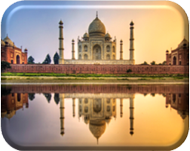 Day 03: Delhi-Agra (200 kns / 4 hrs)
Day 03: Delhi-Agra (200 kns / 4 hrs)
After an early breakfast at hotel drive to Agra.
Agra, situated on the west bank of River Yamuna, Agra was once the flourishing capital of the Muslim rulers of India. Two great Mughal monarchs, Akbar and Shah Jahan, transformed the little village of Agra into a befitting second capital of the Mughal Empire - giving it the name Dar-ul-Khilafat {seat of the Emperor}. Today a visitor to Agra is caught up in a world of contrasting edifices, of red sandstone and white marble, narrow galleys and quaint buggies, and that irresistible charm that this favorite city of the Mughals still retains. It is not surprising, that modern Agra still reflects its Mughal heritage most conspicuously. On arrival, check in at hotel.
After wash and change at hotel visit
Taj Mahal (Closed on Friday) - world's greatest monument to love. Emperor Shah Jahan built this pristine white marble mausoleum in memory of his wife, Mumtaz Mahal. who died giving birth to their fourteenth child in 1631. The monument looks amazingly graceful from almost any angle and took 24 years and 20,000 people to build. The close up detail of the Taj Mahal is as exquisite as the overall architectural design with semi-precious stones and beautiful patterns covering the marble surface. It is one of the Seven Wonders of the World.
Described by the Indian classical poet Tagore as a "tear on the face of eternity", the Taj Mahal is undoubtedly the zenith of Moghul architecture and quite simply one of the world's most marvellous buildings. Volumes have been written on it s perfection, and its image adorns countless glossy brochures and guide books; nonetheless, the reality never fails to overwhelm all who see it, and few words can do it justice.
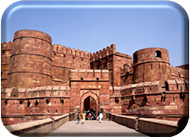 Later visit Agra Fort, built by the Mughal dynasty's greatest Emperor, Akbar, in 1565. A number of the fort’s beautiful palaces, mosques and gardens were built by his successors in later years. Pearl Mosque, it shined like a pearl. It is held that this mosque was constructed by Shah Jahan for his members of royal court. Diwan-i-Khas - Here envoys and other honoured guests were granted a personal audience with the ruler. the Diwan-e-Khas is a small marble structure near the Diwan-e-Am. Diwan-i-Aam - the ruler held mass audience. He would sit on his throne facing petitioners. His minister would assemble the petitions and refer them to the Diwan-e-Khas for private audience. Jahangir Mahal - Jahangiri Mahal is the most important building of the Akbari period in the Agra Fort. Evening free to explore local markets. Overnight at hotel.
Later visit Agra Fort, built by the Mughal dynasty's greatest Emperor, Akbar, in 1565. A number of the fort’s beautiful palaces, mosques and gardens were built by his successors in later years. Pearl Mosque, it shined like a pearl. It is held that this mosque was constructed by Shah Jahan for his members of royal court. Diwan-i-Khas - Here envoys and other honoured guests were granted a personal audience with the ruler. the Diwan-e-Khas is a small marble structure near the Diwan-e-Am. Diwan-i-Aam - the ruler held mass audience. He would sit on his throne facing petitioners. His minister would assemble the petitions and refer them to the Diwan-e-Khas for private audience. Jahangir Mahal - Jahangiri Mahal is the most important building of the Akbari period in the Agra Fort. Evening free to explore local markets. Overnight at hotel.
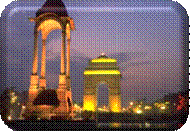 Day 01: Arrive Delhi
Day 01: Arrive Delhi 


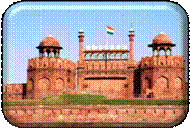 Day 02: Delhi - CYCLE RICKSHAW RIDE
Day 02: Delhi - CYCLE RICKSHAW RIDE Day 03: Delhi-Agra (200 kns / 4 hrs)
Day 03: Delhi-Agra (200 kns / 4 hrs) Later visit Agra Fort, built by the Mughal dynasty's greatest Emperor, Akbar, in 1565. A number of the fort’s beautiful palaces, mosques and gardens were built by his successors in later years. Pearl Mosque, it shined like a pearl. It is held that this mosque was constructed by Shah Jahan for his members of royal court. Diwan-i-Khas - Here envoys and other honoured guests were granted a personal audience with the ruler. the Diwan-e-Khas is a small marble structure near the Diwan-e-Am. Diwan-i-Aam - the ruler held mass audience. He would sit on his throne facing petitioners. His minister would assemble the petitions and refer them to the Diwan-e-Khas for private audience. Jahangir Mahal - Jahangiri Mahal is the most important building of the Akbari period in the Agra Fort. Evening free to explore local markets. Overnight at hotel.
Later visit Agra Fort, built by the Mughal dynasty's greatest Emperor, Akbar, in 1565. A number of the fort’s beautiful palaces, mosques and gardens were built by his successors in later years. Pearl Mosque, it shined like a pearl. It is held that this mosque was constructed by Shah Jahan for his members of royal court. Diwan-i-Khas - Here envoys and other honoured guests were granted a personal audience with the ruler. the Diwan-e-Khas is a small marble structure near the Diwan-e-Am. Diwan-i-Aam - the ruler held mass audience. He would sit on his throne facing petitioners. His minister would assemble the petitions and refer them to the Diwan-e-Khas for private audience. Jahangir Mahal - Jahangiri Mahal is the most important building of the Akbari period in the Agra Fort. Evening free to explore local markets. Overnight at hotel. 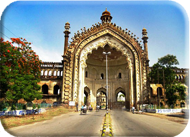 Day 04: Agra-Lucknow (Train)
Day 04: Agra-Lucknow (Train) 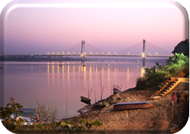 Day 05: Lucknow - Allahabad (200 kms )
Day 05: Lucknow - Allahabad (200 kms )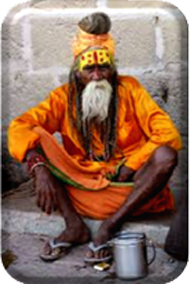 Day 06: Allahabad - Varanasi (120 kms )
Day 06: Allahabad - Varanasi (120 kms ) Evening see AARTI at river Ghat. The Varanasi Ganga Aarti (Ceremony) takes place every sunset at holy Dasaswamedh Ghat, near Kashi Vishwanath Temple.
Evening see AARTI at river Ghat. The Varanasi Ganga Aarti (Ceremony) takes place every sunset at holy Dasaswamedh Ghat, near Kashi Vishwanath Temple.  Day 07: Varanasi - EARLY MORNING BOAT RIDE
Day 07: Varanasi - EARLY MORNING BOAT RIDE